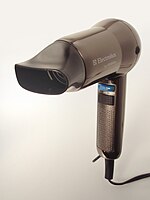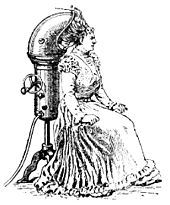Hair dryer

A hair dryer, hairdryer,

Hairstyles using blow dryers usually have volume and discipline, which can be further improved with styling products, hairbrushes, and combs during drying to add tension, hold and lift.
Blow dryers were invented in the late 19th century. The first, stationary, model was created by Alexandre F. Godefroy in his salon in France. The handheld, household hair dryer first appeared in 1920. Blow dryers are used in beauty salons by professional stylists and in the household by consumers.
Function

Most hair dryers consist of electric heating coils and a fan that blows the air (usually powered by a
A survey of stores in 2007 showed that most hair dryers had ceramic heating elements (like ceramic heaters) because of their "instant heat" capability. This means that it takes less time for the dryers to heat up and for the hair to dry.[4]

Many of these dryers have "normal mode" buttons that turn off the heater and blow room-temperature air while the button is pressed. This function helps to maintain the hairstyle by setting it. The colder air reduces frizz and can help to promote shine in the hair.
Many feature "ionic" operation, to reduce the build-up of static electricity in the hair,[5] though the efficacy of ionic technology is of some debate.[6] Manufacturers claim this makes the hair "smoother".[citation needed]
Hair dryers are available with attachments, such as diffusers, airflow concentrators, and comb nozzles.
- A diffuser is an attachment that is used on hair that is fine, colored, permed or naturally curly. It diffuses the jet of air, so that the hair is not blown around while it dries. The hair dries more slowly, at a cooler temperature, and with less physical disturbance. This makes it so that the hair is less likely to frizz and it gives the hair more volume.
- An airflow concentrator does the opposite of a diffuser. It makes the end of the blow dryer narrower and thus helps to concentrate the heat into one spot to make it dry rapidly.
- The comb nozzle attachment is the same as the airflow concentrator, but it ends with comb-like teeth so that the user can dry the hair using the dryer without a brush or comb.
Hair dryers have been cited as an effective treatment for
Types

Today there are two major types of blow dryers (hair dryers): the handheld and the rigid-hood dryer.
A hood dryer has a hard plastic dome that fits over a person's head to dry their hair. Hot air is blown out through tiny openings around the inside of the dome so the hair is dried evenly. Hood dryers are mainly found in hair salons.[8]
Hair dryer brush
A hair dryer brush (also called "hot air brush" and "round brush hair dryer" and "hair styler"[9]) has the shape of a brush and it is used as a volumizer too.[10]
There are two types of round brush hair dryers – rotating and static. Rotating round brush hair dryers have barrels that rotate automatically while static round brush hair dryers don't.
History

In 1888 the first hairdryer was invented by French stylist Alexandre Godefroy.
Around 1920, hair dryers began to go on the market in handheld form. This was due to innovations by National Stamping and Electricworks under the white cross brand,[14] and later U.S. Racine Universal Motor Company and the Hamilton Beach Co., which allowed the dryer to be small enough to be held by hand. Even in the 1920s, the new dryers were often heavy, weighing in at approximately 2 pounds (0.9 kg), and were difficult to use. They also had many instances of overheating and electrocution. Hair dryers were only capable of using 100 watts, which increased the amount of time needed to dry hair (the average dryer today can use up to 2000 watts of heat).[15]
Since the 1920s, development of the hair dryer has mainly focused on improving the wattage and superficial exterior and material changes. In fact, the mechanism of the dryer has not had any significant changes since its inception. One of the more important changes for the hair dryer is to be made of plastic, so that it is more lightweight. This really caught on in the 1960s with the introduction of better electrical motors and the improvement of plastics. Another important change happened in 1954 when

The bonnet dryer was introduced to consumers in 1951. This type worked by having the dryer, usually in a small portable box, connected to a tube that went into a bonnet with holes in it that could be placed on top of a person's head. This worked by giving an even amount of heat to the whole head at once.[17]
The 1950s also saw the introduction of the rigid-hood hair dryer which is the type most frequently seen in salons. It had a hard plastic helmet that wraps around the person's head. This dryer works similarly to the bonnet dryer of the 1950s but at a much higher wattage.[16]


In the 1970s, the U.S.
Cultural references
The British historical drama television series Downton Abbey made note of the invention of the portable hairdryer (blow dryer) when a character purchased one in Series 6 Episode 9, set in the year 1925.
See also
- Curling iron
- Heat gun
References
- ^ "hairdryer noun - Definition, pictures, pronunciation and usage notes | Oxford Advanced Learner's Dictionary at OxfordLearnersDictionaries.com". oxfordlearnersdictionaries.com. Retrieved 23 May 2018.
- ^ "Hairdrier | Collins English Dictionary".
- ^ "Hair Dryer". TheOriginOf.com. 16 February 2008. Archived from the original on 18 May 2011. Retrieved 26 October 2015.
- ^ Kirkland, Kathy (June 2004) "The Big Blow-Dryer Boom", Beauty Story Business
- ^ Krupnick, Ellie (5 November 2013). "9 Ways To Win The War on Static Hair". HuffPost. Retrieved 26 October 2015.
- ^ "How do "ionic" hair dryers affect the hair, short-term and long term?". UCSB ScienceLine. Retrieved 26 October 2015.
- S2CID 9482708.
- ^ "What is a hair hood dryer?". WiseGeek. Retrieved 24 May 2012.
- ^ "It's Official: This Charcoal-Infused Hair Styler Just Dethroned the Revlon Hot Air Brush on Amazon". 11 February 2020.
- Insider.com.
- ISSN 0362-4331. Retrieved 8 September 2023.
- ISSN 0362-4331. Retrieved July 5, 2016.
- ^ Kazanjiadl "Hair-Drier" U.S. patent 994,259, assigned on 6 June 1911
- ^ "The Evening Independent - Google News Archive Search". news.google.com. Retrieved 23 May 2018.
- ^ "Hair Dryer". MadeHow.com. Retrieved 26 October 2015.
- ^ a b Electric Hair Dryers. ntlworld.com
- ^ Hart, Maria Teresa (1 August 2017). "The Hair Dryer, Freedom's Appliance". The Atlantic. Retrieved 11 September 2023.
- ^ Toothman, Jessika; Meeker-O'Connell, Ann (15 December 2000). "How Hair Dryers Work". HowStuffWorks.com. Retrieved 26 October 2015.
External links
 Media related to Hairdryers at Wikimedia Commons
Media related to Hairdryers at Wikimedia Commons
